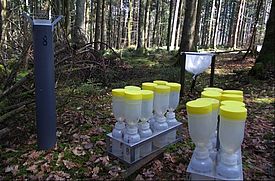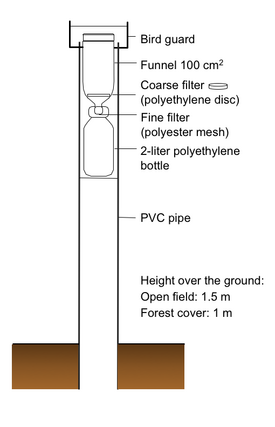Agricultural activities and combustion processes release pollutants such as ammonia (NH3), nitrogen dioxide (NO2) and sulphur dioxide (SO2) in the atmosphere. These substances enter the forest ecosystem as gas or particles, or dissolved in precipitation in form of ammonium (NH4+), nitrate (NO3-) and sulphate (SO42-). They can accelerate the acidification of forest soil.
In addition, nitrogen compounds have a fertilizing effect, which can promote tree growth. However, in large quantities, nitrogen can disrupt the nutrient balance of the trees.
We use rain and snow collectors (4) in the open field and under forest cover to quantify the precipitation and the nutrient and pollutant input into the forest ecosystem. In addition, stemflow (10) measurements allow us to monitor the inputs that reach the soil along the trunk.
The rain collectors are exchanged with clean ones every other week. The exposed collectors are brought back to the laboratory for determining the quantity of precipitation and its chemical composition.
Objectives of the measurements
In combination with snow collectors (4) and stemflow collectors (10), rainfall collectors allow the following:
- to quantify atmospheric deposition, i.e., the input of sulphur, nitrogen and other pollutants and nutrients from the air into the forest ecosystem;
- to record precipitation as well as interception of snow and rainfall by the canopy.
Depositionswerte ¶
Atmospheric deposition on LWF sites
The annual atmospheric deposition, calculated for each LWF site after data validation (precipitation, chemical analyses), can be visualized in graphical form using the interface below.

